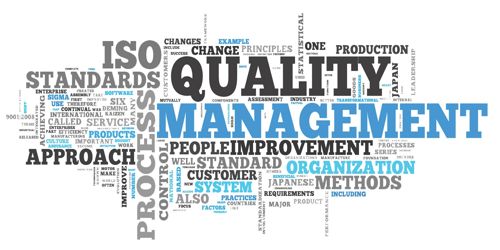Quality management has become an essential part of all businesses. No matter what type of industry you call your executive home, this topic is sure to be on the forefront of all business processes you implement. Quality management is the act of overseeing all activities and tasks needed to maintain a desired level of excellence. This includes the determination of a quality policy, creating and implementing quality planning and assurance, and quality control and quality improvement. It is also referred to as total quality management (TQM).
Quality management systems serve many purposes, including:
- Improving processes
- Reducing waste
- Lowering costs
- Facilitating and identifying training opportunities
- Engaging staff
- Setting organization-wide direction
Quality management is the process of controlling, ensuring, and improving quality; both in business operations and productivity. If customers are satisfied, chances are they feel they are receiving high-quality products that are constantly improved upon in order to keep up with the ever-changing times.
Quality management
The advances in communication and transportation technology coupled with open market economy have made people from all over the world a global customer. Now a garment is designed in Italy, the raw material is coming from China, the fabric may go to India and then it is marketed in New York, Paris, and London. Another counterpart may choose to collect raw material from India, make in Bangladesh and sell in New York, Paris and London. This example shows how a garment manufacturer in Bangladesh is competing with Indian counterpart. This type of global competition is taking place everyday. This used to be a norm for large organization but now for open market economy small organizations are forced to play this role.
The global market place exerts enormous, relentless pressure on the organizations to continually improve quality while simultaneously reduce the price they charge for goods and services. The key to achieve higher quality and lower prices for customer is the reduction of expenses associated with unhappy customers… expenses that amount as much as 25% of the cost of sales. The cost of poor quality accounts for 15-30% of a company’s overall costs. When an organization does what is necessary to improve its performance by reducing deficiency in key areas (cycle time, warranty costs, scrap and rework, on time delivery etc.) , it can reduce overall costs without eliminating essential services, functions, product features and personnel. Reducing cost associated with poor quality is mandatory for companies that hope to compete in the global market. The flowing figure shows how a poor quality cost.
Benefits of quality management systems
Implementing a quality management system affects every aspect of an organization’s performance.
Two overarching benefits to the design and implementation of documented quality management systems include:
- Meeting the customer’s requirements, which helps to instill confidence in the organization, in turn leading to more customers, more sales, and more repeat business
- Meeting the organization’s requirements, which ensures compliance with regulations and provision of products and services in the most cost- and resource-efficient manner, creating room for expansion, growth, and profit
Within these overarching benefits are advantages like helping to communicate a readiness to produce consistent results, preventing mistakes, reducing costs, ensuring that processes are defined and controlled, and continually improving the organization’s offerings.
Benefits of Quality Management System
Increased Efficiency: Businesses who go through the ISO 9001 QMS certification process have the aim to maximize the efficiency and quality of their processes. As part of the process, guidelines will be put in place for all employees to follow.
Better Employee Morale: Members of staff need to be motivated and satisfied to perform well. Clear, defined roles, accountability of management, established training systems as well as a clear understanding of how their roles affect the quality and the success of the business are all part of fostering an effective employer/staff relationship.
International Recognition: ISO is a worldwide mark of quality management, making a business appear reliable and trustworthy.
Improvement of Processes: You can learn what improvements are needed by the facts that you find through a system of documentation and analysis.
In short, if it comes to a decision between a larger business with no quality management system, and a small business with ISO certification, small businesses will certainly be likely to outshine their larger rivals, with ISO as a selling tool, and it will work to ensure that once any contract is won, it will likely be on a long term basis, as the steps necessary to provide a robust customer experience are already in place.
A successful business is like a well-oiled machine. Team members work together to ensure their area turns out quality work. All those areas come together in one big corporation that offers customers products or services that serve a specific purpose. That is why it is important for managers to keep all areas informed of what is going on in the organization as a whole. If each area understands what the others are doing and why they exist, the work turned out will be more uniform and pointed toward a specific cause.
Conclusion
High quality means success. Happy customers will be returning ones and that is what every organization strives for at the end of the day. Quality management is a process that must receive constant attention in order to be successful. That is why there are employees devoted to controlling, maintaining, and improving quality on an ongoing basis.
Information Source:
















